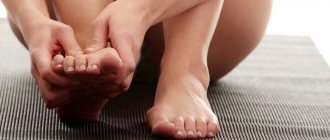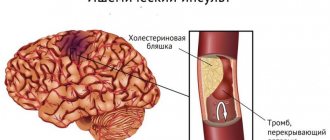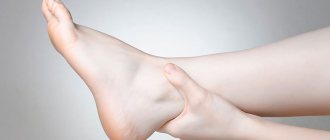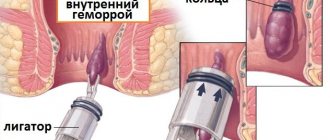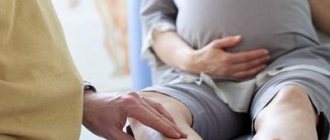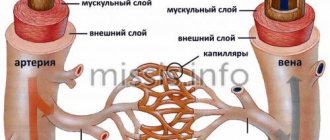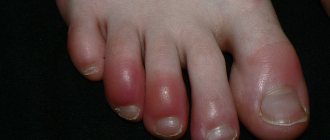Edema is a condition in which excessive amounts of fluid accumulate in certain organs or intercellular spaces. Swelling of the legs is especially common, since the lower extremities are constantly exposed to increased stress. The fluid is mainly localized in the area of the legs and feet.
Swelling can occur on one limb or on both. They usually appear in the evening.
Physiological reasons
In a healthy person, edema may appear in the evenings after heavy physical exertion or prolonged standing as a result of increased hydrostatic pressure in the blood vessels. The likelihood of swelling increases in the heat, when staying in a stuffy room or at high altitude, when drinking a large volume of liquid, excessively enjoying salty foods, and abusing alcoholic beverages (salt and alcohol retain water).
Swelling of the feet is especially common in women when wearing high-heeled or high-platform shoes. Due to the unnatural position of the foot, blood circulation in the lower extremities is significantly impaired, which leads to stagnation and accumulation of fluid. Similar processes are observed if you wear too narrow shoes and shoes with flat soles.
For physiological reasons, the swelling is mild and symmetrically covers the ankles and feet (occasionally the lower legs). When pressed with a finger, they leave an instantly disappearing mark. After rest they disappear completely.
If the legs swell for physiological reasons in women and men, then there is no need for special treatment. It is enough to adjust your lifestyle.
Hormonal fluctuations in women
In women, before the onset of menstruation, the concentration of progesterone in the blood decreases, which can cause fluid retention, causing pasty (swelling) ankles. Swelling is most pronounced during premenstrual syndrome.
During menopause, hormonal levels are constantly changing, so women may periodically swell their lower extremities. This problem can also be the result of hormone replacement therapy.
During reproductive age, swelling of the legs may occur when taking oral contraceptives.
ORTEKI phlebologist explained why legs swell and how to solve this problem
ORTEKI surgeon-phlebologist Armen Avakyan shared with readers of the sports Internet portal championat.com tips on how to avoid swelling of the legs.
When we do not move for a long time, whether working in an office, sitting in a car or on an airplane, the leg muscles do not contract and therefore do not contribute to blood flow. This causes stagnation of blood in the veins of the lower extremities. Which, in turn, can cause pain, heaviness, fatigue in the legs and swelling.
Edema is a symptom of improper functioning of the venous system. If you ignore it, you can provoke or aggravate the development of varicose veins and chronic venous insufficiency.
Why do my legs swell?
Blood moves through the vessels first from the heart to the tissues and organs - filling them with oxygen and nutrients. And then it goes back to the heart, carrying metabolic products and carbon dioxide. In this case, the arteries are responsible for the movement of blood from the heart, and the veins are responsible for the return flow to it.
Blood flows through the veins of the lower extremities from bottom to top. Its correct movement is controlled by valves, which maintain blood flow strictly in one direction towards the heart at relatively low pressure in the veins. The largest number of these valves are located in the veins of the legs, in particular in the lower leg area. Their work depends on muscle contractions that stimulate blood movement. This mechanism is called the musculovenous pump of the leg.
When we do not move for a long time, work in an office, sit in a car or are on an airplane, the leg muscles do not contract and therefore do not contribute to blood flow. This causes stagnation of blood in the veins of the lower extremities. What causes pain, heaviness, fatigue in the legs and swelling.
Edema is usually experienced by office workers who move little. They also often occur in those who constantly work “on their feet”: hairdressers, surgeons, salespeople, stylists, teachers, doctors, etc. Excessively intense sports can also be dangerous for the venous system of the legs: for example, increased pressure when lifting weights negatively affect the condition of the veins. In addition, swelling of the legs often appears in pregnant women, since during this period the woman’s venous system is heavily overloaded.
How to prevent swelling?
It’s worth preparing for a long trip by choosing comfortable shoes in advance. In narrow shoes or in a pair of the wrong size, the feet experience extra stress, even in a static position. Because it creates a lot of pressure on the forefoot. This can impair circulation and cause swelling as the legs are constantly tense.
A suitable shoe option is with a heel 2-4 cm high, a wide front section and a shape-resistant heel. It is recommended to wear shoes with these parameters every day, not only when traveling.
“Smart” compression hosiery helps to take care of the health of your legs during long trips. These are special medical devices that recognize situations when the venous system of the lower extremities needs support. They help eliminate pain and swelling, and help get rid of the feeling of fatigue and heaviness in the legs.
Compression jersey applies a strictly specified pressure to the surface of the legs. It is distributed unevenly along the leg: from the maximum value in the ankle area to the minimum in the shin or thigh area, depending on whether it is knee socks, stockings or tights.
This pressure stimulates the venous system of the legs. Blood circulates better, stagnation and conditions for the formation of edema disappear.
What exercises help relieve swelling?
To improve your well-being, your doctor recommends doing warm-up exercises more often. The simplest exercises will do:
- head rotation;
- circular movements with hands;
- lunges with alternating legs;
- stretching;
- bends;
- squats.
This exercise helps improve metabolic processes in the body, accelerate blood supply to the muscles and saturate them with oxygen. You will not only cheer up, but also improve the functioning of the venous system. Remember: if we move, the muscular-venous pump is actively working, which means blood flow improves.
Since blood moves from the bottom up through the veins of the legs, it is useful to keep the legs above the level of the heart. You can periodically sit with your feet on the table, because this position promotes blood flow. Also, to prevent vein diseases, you need to adhere to the right lifestyle. Sport improves muscle function and blood circulation in general. Moderate exercise in the gym, walking, running, swimming and similar activities help prevent swelling and other problems with veins.
Source
Pathological causes
Quite often the legs swell in people with health problems.
Swelling is a symptom that accompanies:
- Traumatic injuries When injured, the skin usually becomes bluish or purple, abrasions and bruises appear, and the tissues become swollen. In case of injury, the swelling is always one-sided, located at the site of injury, and can spread to nearby tissues. Swelling of the limb is possible with bone fractures, dislocations, ligament damage, meniscus tears, severe bruises, burns, frostbite.
- Purulent processes With purulent lesions of the skin, soft tissues, bones, joints, dense swelling is localized in one place, quickly increasing in size. It is combined with redness or cyanosis of the skin, jerking pain, and signs of intoxication of the body.
- Kidney diseases Due to malfunctions of the kidneys, their filtering abilities are impaired and the tubules are damaged. As a result, the kidneys do not have time to remove fluid from the body, which is why it moves from the blood vessels into the tissues, which causes swelling of the feet and legs. In this case, the swelling is symmetrical, soft, watery, and elastic. In addition to the legs, they cover the arms, stomach, and face. They appear very quickly, often in the morning. An additional symptom is yellowing of the skin. Most often, the lower extremities swell with nephritis, pyelonephritis, glomerulonephritis, renal amyloidosis, nephrosis, membranous nephropathy, chronic renal failure.
- Pathologies of the heart and blood vessels In diseases of the cardiovascular system, edema is symmetrical and dense, pasty ankles and feet may be observed. Occasionally, swelling completely covers the lower leg, reaching the knees. In this case, swelling appears and resolves very slowly (within several weeks), the skin acquires a bluish tint and becomes cool. Most often, swelling of the legs is evidence of the initial stage of varicose veins. In this case, the swelling is accompanied by pain and heaviness in the lower extremities. Later, other signs appear - convulsions, protruding veins. In healthy people, due to the contraction of the muscles in the legs, venous blood moves from bottom to top. Venous valves prevent blood from flowing in the opposite direction. With varicose veins and thrombophlebitis, the functioning of the valves is disrupted, which is why blood begins to move in two directions. At the same time, it stagnates in the veins, which leads to increased venous pressure, thinning of the vein walls, and loss of tone. As a result, the permeability of the vessels increases, the fluid from them moves into the surrounding tissues, causing swelling. In addition, due to stagnation, the blood thickens, which increases the risk of blood clots. Swelling can be a symptom of thrombosis, cardiomyopathy, cardiosclerosis, cardiac amyloidosis, arterial hypertension, postthrombophlebitis disease, arrhythmia, constrictive pericarditis, heart failure. Due to impaired lymph outflow, edema can occur due to lymphostasis, lymphedema, removal of lymph nodes, or compression of lymph vessels by tumors. In this case, the swelling is one-sided, very dense and persistent. When pressing with a finger, a dent does not form.
- Joint diseases A common cause of swelling of the ankle and knee joints is arthritis (rheumatoid, psoriatic, gouty, reactive, infectious) and arthrosis. In arthritis, swelling can be symmetrical and asymmetrical, unilateral and bilateral. It is combined with pain, hyperthermia, local hyperemia, a feeling of stiffness, and limitation of movements. With arthrosis, swelling is almost invisible, intensifying during periods of exacerbation.
- Metabolic disorders A common cause of swelling is metabolic disorders (for example, diabetes mellitus). The problem is aggravated in obese people, whose lower limbs are subject to increased stress.
Swelling of the legs as a symptom of pathological conditions and diseases
Swelling caused by a physiological cause is usually symmetrical, that is, it is observed on both legs at once. Such swelling is usually mild; If you press with your finger, a mark remains at the point of pressure, which disappears right before your eyes. When physiological conditions are restored to normal, edema quickly disappears. The absence of these signs, especially if the swelling does not go away within 24 hours, is a reason to consult a doctor: in this case, the swelling is most likely caused by a pathological cause.
The list of diseases, the manifestation of which can be swelling of the legs, is extensive. Here are the main ones:
- heart failure. If the heart's activity is impaired, it cannot maintain blood circulation at a sufficient level. Congestion occurs, and first - in the area furthest from the heart, and these are precisely the legs (feet, ankles and legs). The swelling that occurs for this reason is symmetrical; swelling intensifies in the evening (under the influence of gravity, blood accumulates in the lower part of the circulatory system);
- vascular diseases. With varicose veins, swelling increases gradually as the disease develops. My legs get tired, and in the evening they begin to ache and swell. By morning the swelling goes away. If one leg is swollen (and hurts), then it may be phlebitis (inflammation of a vein) or thrombosis (a thrombus blocks the lumen of the vessel, as a result of which the blood flow is disrupted, plasma enters the surrounding tissues, causing swelling);
- renal pathology. With renal origin, the peak of swelling occurs in the morning. At the same time, not only the legs swell (swelling on the face is characteristic - “bags under the eyes”), but mainly the feet swell on the legs;
- liver diseases (cirrhosis, liver cancer);
- lymphostasis (impaired lymph outflow);
- erysipelas is an infectious disease caused by group A streptococcus. Lymphostasis is often a consequence (complication) of erysipelas;
- joint diseases - rheumatoid arthritis, injuries, etc. In this case, the affected joint swells;
- thyroid dysfunction. With hypothyroidism, swelling (myxedema) can be observed throughout the body, including the legs. With hyperthyroidism, the surface of the lower leg thickens (in front, just above the ankle). At the site of swelling, the skin becomes keratinized and flaky, hair falls out (hair follicles are lost). When you press on the swelling, there is no trace left, it is elastic, it cannot be crushed into a fold;
- allergic reactions. With allergic arthritis, the joints become swollen. Possible swelling from insect bites.
Individual treatment of edema is ineffective. Edema can be removed if the cause that caused it is random (physiological edema, minor injuries, insect bite). In other cases, treatment of the disease is required, the symptom of which is swelling of the legs.
Other reasons
The answer to the question “Why do my legs swell and how to deal with it?” People suffering from:
- endocrine pathologies (myxedema, hypothyroidism, hyperaldosteronism, Ishchenko-Cushing's disease);
- exhaustion (anorexia nervosa, nutritional cachexia, severe weight loss after serious illness or surgery);
- nervous disorders (paresis, paralysis).
In the above cases, the edema is mild or moderate, symmetrical (with the exception of unilateral paralysis), soft. They do not change during the day, occasionally increasing in the evenings.
- Allergic reactions Under the influence of allergens, fluid rapidly accumulates in the tissues, which leads to instant swelling of the legs. In this case, the skin becomes red in color and itching appears.
- Obesity Due to excess weight, pressure on the lymphatic vessels and veins increases, which leads to disruption of lymphatic and venous outflow.
- Taking medications Some medications (vasodilators, antihypertensives, antidiabetics, calcium channel blockers, nonsteroidal anti-inflammatory drugs) can cause swelling of the lower extremities.
Why do older people often have swollen feet?
In old age, the work of all organs and systems slows down and faces an imbalance, which causes a deterioration in the general condition. The formation of edema indicates changes in the body and requires contacting a doctor for examination.
The main physiological reason is poor blood circulation and thinning of the walls of blood vessels. This is caused by lack of physical activity, as well as the use of uncomfortable shoes. High heels shift the center of gravity, and very tight, narrow shoes disrupt blood flow. Swelling in older people can be caused by old injuries or fractures that disrupt the functioning of the body. Systematic unbalanced nutrition increases stress on the body and causes the formation of excess fluid. Another reason is taking pills, this was mentioned above.
Swelling of the legs during pregnancy
Why do pregnant women's legs swell? Physiological and pathological reasons can cause the problem. Physiological factors include increased stress on the legs as a result of weight gain, hormonal changes (increased progesterone concentration), and compression of the inferior vena cava by the uterus. The pathological cause is gestosis (late toxicosis). In this case, the severity of symptoms can vary greatly - from slightly noticeable pastiness to severe swelling of the entire body (lower and upper limbs, face).
Why does leg swelling increase in hot weather?
In hot weather, the body tries to restore heat metabolism by dilating blood vessels. As a result, blood flow to the lower extremities increases, and, if there is pathology of the venous or lymphatic system, the appearance of edema increases.
Types of leg swelling
Depending on the cause, there are several types of edema:
- stagnant - develop due to stagnation of venous blood and increased vascular permeability in people with varicose veins and thrombophlebitis;
- hydromic – accompany kidney disease;
- neuropathic – typical for people suffering from diabetes and alcoholism;
- cachectic - occur with nutritional deficiency caused by chronic anemia, lack of protein in food, the presence of malignant tumors;
- allergic – the body’s reaction to exposure to allergens;
- mechanical - the result of compression of blood vessels, injury to bone or soft tissue structures/
“Female” causes of leg swelling
In women, swelling of the legs can be caused by special reasons:
- premenstrual syndrome. Before menstruation, the hormonal balance is disrupted - the relative content of estrogens increases, and estrogens retain fluid in the body;
- pregnancy. During pregnancy, a woman's body produces a large amount of progesterone, which reduces vascular tone. This contributes to stagnation of blood in the legs. The growing fetus can compress large vessels, which also causes edema - this reason becomes significant in the later stages. Swelling can also be a manifestation of gestosis (late toxicosis of pregnancy).
Diagnostics and tests
At the initial appointment, the therapist listens to the patient’s complaints, conducts a physical examination and palpation, and collects an anamnesis of the disease.
A diagnostic examination for swelling of the legs will help to find out the causes and select treatment for women and men:
- general and biochemical blood test - detects gout and atherosclerotic damage to blood vessels;
- blood sugar test - determines diabetes mellitus;
- blood test for hormones – examines hormonal levels;
- general urinalysis – assesses kidney function;
- Ultrasound – detects diseases of blood vessels, heart, kidneys, endocrine glands;
- electrocardiography – diagnoses cardiac pathologies;
- X-ray – detects fractures and joint diseases.
If necessary, Doppler ultrasound, duplex scanning of blood vessels, electroencephalography, CT, and MRI are additionally performed.
Based on the diagnostic results, the therapist can give a referral to specialized specialists (phlebologist, angiosurgeon, cardiologist, nephrologist, hepatologist, urologist, gastroenterologist, endocrinologist, orthopedist).
Which doctor should I contact for swelling of the legs?
If you have swelling of the legs, you should first consult a general practitioner (general practitioner or family doctor). In order to determine the cause of the swelling, a simple examination may not be enough. You must be prepared that you will need to undergo a series of tests or undergo instrumental examination (ultrasound, MRI). In some cases, after receiving the results of the examination, the therapist may refer you to specialized specialists (cardiologist, urologist, etc.).
Treatment
There are many ways to quickly solve the problem, but the result is temporary. To get a stable effect, it is necessary to establish why the legs swell and eliminate the cause of the pathology.
Conservative therapy
If your legs swell very much, your doctor will tell you what to do. He will select medications depending on the cause of the problem.
For pathologies of the kidneys and heart, diuretics and antihypertensive drugs, immunosuppressants are prescribed, and hemodialysis is performed according to indications.
For varicose veins, the doctor selects phleboprotectors or venotonics. These drugs strengthen the veins and normalize venous circulation. Special ointments and compression garments will help relieve unpleasant symptoms.
For heart diseases, diuretics, vasodilators, adrenoblockers, ACE inhibitors, glycosides, and anticoagulants are selected.
For joint diseases, non-steroidal anti-inflammatory drugs (in the form of ointments, tablets, injections), physical therapy, massage, and physiotherapy are recommended. In case of fractures and dislocations, a plaster cast is applied or skeletal traction is used. Additionally, analgesics, massage, and physiotherapeutic procedures are prescribed.
Local infections are suppressed with antibacterial, antiviral or antifungal drugs.
Lymphatic drainage massage provides a good effect. It activates metabolism and lymph flow, which eliminates puffiness. Additionally, therapeutic and compression therapy, taping, osteopathy, and manual therapy are recommended. Physiotherapeutic procedures improve local blood circulation, relieve inflammation and pastosity.
Surgery
If conservative treatment does not have the desired effect for swelling of the legs, surgical intervention is recommended:
- For heart pathologies: o pericardiectomy – the pericardium is removed; o interventions on valves, partitions, chambers; o radiofrequency ablation; o implantation of a pacemaker.
- For vascular diseases: o sclerotherapy; o phlebectomy; o thrombectomy; o thrombolysis; o laser coagulation; o EVLO; o RFO; o bypass surgery; o tunneling.
- For kidney damage: o organ transplantation.
- For joint diseases: o arthroplasty; o arthrodesis; o endoprosthetics.
- For traumatic injuries: o plastic surgery of ligaments; o osteosynthesis; o meniscectomy.
- During purulent processes: o opening of abscesses, phlegmons, boils, carbuncles; o arthrotomy; o sequestrectomy.
What to do with swelling
If swelling develops, especially if it is chronic, you should immediately consult a doctor. To establish the true cause of fluid accumulation, specialists will definitely prescribe a wide range of studies. As a rule, diagnosis begins with a physical examination of the patient and collection of anamnesis, after which the patient undergoes tests and, if necessary, undergoes instrumental examinations.
• General and biochemical blood tests show the level of red blood cells, hemoglobin, ESR, cholesterol. This is necessary to exclude atherosclerotic vascular lesions and gout. • Blood sugar test to rule out diabetes. • Urinalysis to quantify protein levels. • Hormonal tests. • Ultrasound and electrocardiography to detect heart and vascular diseases.
After general examinations, the doctor can refer the patient to specialized specialists for additional diagnostics if certain pathologies are suspected. For example, if varicose veins are suspected, an ultrasound scan of the veins in the legs may be prescribed. In any case, diagnosis and therapy should be carried out exclusively by a doctor. It is important to eliminate not only swelling, but the underlying disease that caused it. The type (drug or non-drug, surgical, conservative) and intensity of therapy are also selected by a specialist. For example, for heart or kidney disease, certain diuretics are prescribed.
When it comes to varicose veins, the basic drugs are venotonics or phleboprotectors, which correct disturbances in the functioning of the venous circulatory system, strengthen blood vessels and restore venous flow. Special ointments and gels are also used that reduce skin sensitivity and discomfort in areas of swelling. In some cases, wearing compression garments is indicated to relieve symptoms. In the later stages of varicose veins, the problem can only be solved through surgery - for this, phlebectomy, sclerotherapy or EVLO (endovasal laser obliteration) is prescribed. However, in some cases it is possible to get rid of swelling without medication or surgery.
Osteopathy is a system of diagnosis and treatment of diseases of the musculoskeletal system, internal organs and systems without drugs. It is based on the anatomical-functional unity of the body and uses manual methods that restore the body's ability to heal itself.
Changes in the legs can be caused by weakness, overexertion, muscle or joint stiffness. The osteopathic correction scheme depends on the complexity, severity of the pathological process and the root causes that caused it.
In the initial stages of the disease, osteopathic manipulations help avoid the progression of leg disease, preventing the need for drug therapy and surgical intervention on the legs.
Osteopathic medicine views the human body as a single system that constantly adapts to new conditions. When any organ is ill or injured, other systems regulate and compensate for its functioning, which causes pain, swelling or inflammation.
Osteopathic treatment of swelling at the Quality of Life clinic is aimed at normalizing metabolism and digestive processes, which has a beneficial effect on the health of the entire body as a whole. Osteocorrection affects all systems, normalizes their functioning and brings them to a natural state. It allows you to effectively eliminate all negative phenomena, including swelling, shortness of breath, heartburn, disturbances in the gastrointestinal tract and the musculoskeletal system. Osteopathic medicine has no contraindications and can be used by both pregnant women and children.
Our doctors use gentle techniques that relieve tension, normalize blood circulation and lymph flow in the legs, improve vascular tone, provide lymphatic drainage and reduce fluid accumulation. In addition, this impact:
• relaxes muscles and fascia; • reduces or completely eliminates pain; • normalizes metabolism and hormonal levels; • restores anatomical mobility of joints.
Work is also carried out at the level of the diaphragm - thoraco-abdominal and pelvic. This normalizes pressure in the abdominal cavity, restores the functionality of all organs and systems, including blood vessels, which, due to disorders, are forced to work harder. As a result, the entire body is brought into a state of harmonious balance, which has a positive effect on the hormonal and psycho-emotional background. Working with soft tissues normalizes blood and lymph flow. This improves the nutrition of bones and joints, which do not have blood vessels, so the main source of nutrients in them is only the surrounding tissue. Improving bone nutrition eliminates pathological processes faster.
Treatment with lymphatic drainage massage is highly effective. It improves lymph flow, accelerates metabolic processes, relieves swelling and stabilizes the functioning of the central nervous system. This method is combined with other physiotherapeutic procedures - physical therapy, kinesiological taping, compression therapy.
Complex therapy, combining different methods, promotes a speedy recovery by reducing inflammation and swelling of tissues, improving blood circulation at the site of inflammation. As a result, recovery occurs much faster. Preventive courses every six months reduce the likelihood of exacerbations of swelling in the legs. The combination of osteopathy, manual therapy, kinesiotherapy and exercise therapy forms new motor patterns in the legs, stops the progression of diseases, prevents exacerbations and improves the quality of life. The set of physical exercises is selected individually by the attending physician, but even if you do simple movements correctly, they will have results.
Prevention
To avoid the question: “Your legs are swollen, what should you do?”, you should follow some rules:
- eat rationally - include more foods containing potassium in the menu and minimize the consumption of foods rich in sodium;
- wear comfortable low-heeled shoes;
- do not sit for a long time with your legs tucked or your legs crossed;
- massage your feet periodically;
- take a contrast shower, arrange foot baths;
- lead an active lifestyle: walk, swim, do aerobics;
- when resting and during sleep, place your feet on a pillow or bolster so that they are located above the level of the heart;
- to refuse from bad habits;
- undergo preventive examinations in a timely manner and treat concomitant diseases.
Recommendations
To achieve and maintain the effect, the action plan, in addition to the main therapy, may include compliance with certain lifestyle recommendations. These include: • Do not sit for a long time in one position with your legs tucked. • Change shoes frequently (at least 1-2 times throughout the day). • Periodically massage your feet using rubbing or pinching movements. • Balance your diet by adding foods with potassium and reducing your intake of sodium-rich foods. • When sleeping, place a special cushion or a regular pillow under your shins so that your lower extremities are above the level of your heart. Before going to bed, you need to raise them and keep them in this position for 5-10 minutes to relieve accumulated fatigue and tension. • In the early stages of varicose veins, physiotherapy, diet therapy and physical therapy are very useful, which can only be done under strict medical supervision.
Unfortunately, with an advanced disease, it is not possible to limit yourself to just lifestyle changes or physical activity - edema requires therapy. Therefore, you need to consult a doctor in a timely manner, preferably at the earliest stages of the development of the pathology, so that all the unpleasant sensations in the legs go away and your gait becomes light and relaxed again. Then the treatment will be effective, and the chances of a full recovery will be as high as possible.
Similar articles:
- Directions
- Specialists
- For visitors
- Articles and videos
“Healthy Summer” 1000 rubles discount on an appointment with osteopathic doctor E.A. Ukhmylin.
Adult admission 6 thousand, children admission 5 thousand.
